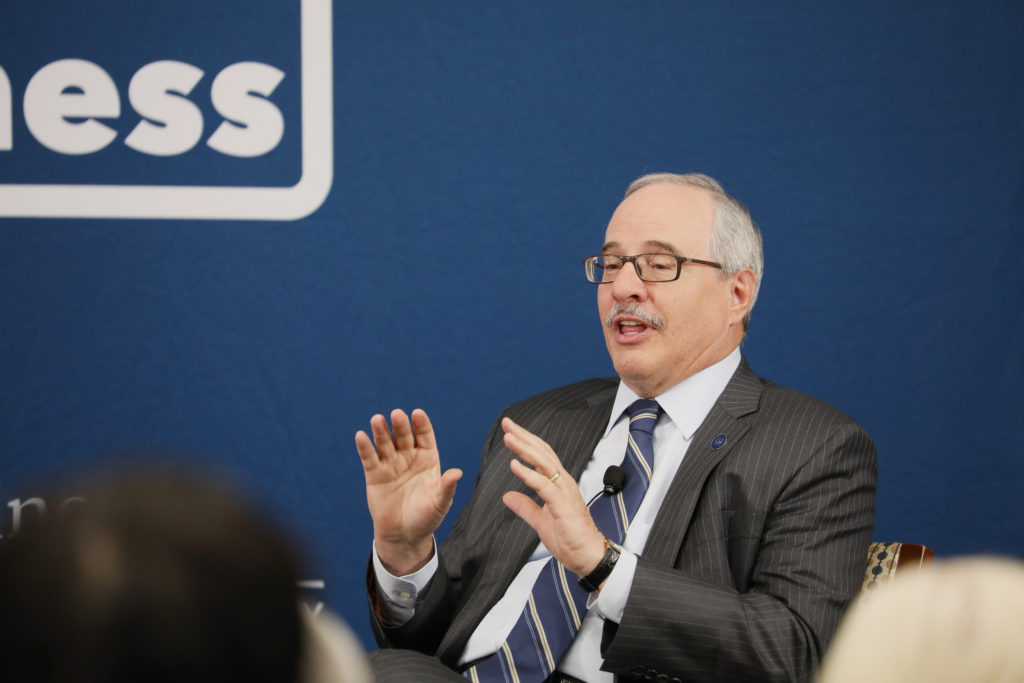University President Thomas LeBlanc will visit more than 10 cities over this academic year to connect with alumni, families and recently admitted students.
Matt Lindsay, the assistant vice president of marketing and communications in the Division of Development and Alumni Relations, said LeBlanc will host “alumni and community events” in 10 metropolitan regions in the United States and in one other country prior to the end of the academic year. The trips follow LeBlanc’s stops in six U.S. cities last year to outline his priorities and connect with alumni, donors and parents of current students.
“This travel allows President LeBlanc to communicate firsthand with community members outside of Washington, D.C., and to generate additional philanthropic support for important GW initiatives,” Lindsay said in an email.
Lindsay said the locations were selected primarily on the “size” and “scope” of the GW community in each region, and officials plan to invite alumni, parents, family members and newly admitted students to the events. The trips include a visit to Philadelphia on Jan. 14, Los Angeles on Jan. 28, San Francisco on Jan. 30 and Northern Virginia on March 3, according to emails sent to parents living near the event locations.
“GW President Thomas J. LeBlanc is traveling the globe to listen, learn and engage the GW community toward a collective vision,” officials said in the emails.
Lindsay said LeBlanc will fundraise for “critical” GW programs during his trips, which come as officials plan to launch the University’s next major fundraising campaign in 2021 in conjunction with GW’s bicentennial anniversary. LeBlanc established philanthropy and constituent engagement as one of his five top priorities as president.
“This is an important and exciting time for members of the GW community to deepen their engagement and share their input on how we continue to improve GW,” Lindsay said.
Lindsay declined to provide the specific locations of LeBlanc’s trips. He also declined to say how much the trips will cost.
Higher education experts said presidential trips can reconnect alumni with the University and increase fundraising levels by engaging donors and alumni in person.
Mark Stater, an associate professor of economics at Trinity College, said travel allows the president to meet “face-to-face” with donors around the globe to attract more donations, which is critical because the president’s main job is fundraising.
“Hopefully, at the very least, connections made that are likely to lead to donations later,” he said in an email. “But at a certain point, these trips need to produce fundraising results.”
Fundraising staff conducted almost 5,000 visits to donors in an effort to retain existing donors and attract new ones last fiscal year. GW experienced the lowest alumni giving rate among its peer institutions for the second year in a row but notched its third-highest fundraising amount last fiscal year.
Stater said presidential travel can increase the University’s visibility and inform alumni and parents about events at the school. But travel can also detract from the president’s ability to govern and deal with business on campus, he said.
He added that the success of a presidential trip can be evaluated by determining whether the money the president brings in exceeds the cost of the trip, and many alumni are more likely to donate at in-person events.
“They should try their best to make sure the president will be meeting with donors who are likely to give, in settings where they are likely to give,” he said.
Robert Shand, an assistant professor of education at American University, said presidential travel can raise the University’s profile and build new potential partnerships to share the University’s work with other communities and bring in revenue, research grants and contract work.
Shand added that university presidents are often criticized for their “generous compensation” and “perks,” like global travel, but presidents typically bring in more than the cost of their job through fundraising dollars, publicity for the school and new programs.
“Ultimately, I think the responsibility lies with the board to ensure that the trips are indeed bringing value to the University that could not have been done otherwise, and the trips are done at a reasonable cost,” he said in an email.
Karna Lozoya, the executive director of strategic communications at Catholic University of America, said presidential travel is essential for “expanding the University community” and maintaining good relations with its constituencies.
“When a president visits a city, it normally generates events that bring together alumni, parents and donors,” she said in an email. “These events are important community builders.”
Lozoya said “smart use” of presidential travel can improve the University’s relationship with parents and student recruitment through continued engagement with communities around the globe.
Family donations hit the highest level the University has seen in seven years last fiscal year, clocking in at $15.7 million after a three-year decline.
“There might not be time to meet with everyone suggested, but it’s key to be intentional and proactive about maximizing travel time, for the good of the university,” Lozoya said.





